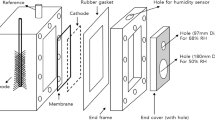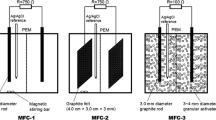Abstract
Power overshoot that presents in the power curves of microbial fuel cells (MFCs) is one of the main reasons for the deterioration of MFC performance over the high current region. In this research, the mechanisms of power overshoot were investigated with single-chamber MFCs integrated with carbon cloth anode and Fe/N-doped carbon cathodes possessing varied capacitance properties. It was revealed that insufficient anodic current produced at high potential is responsible for power overshoot generation, which could be eliminated with higher capacitive cathode (7.79 F) compared with the one with lower capacitive cathode (3.74 F). This elimination can be ascribed to the improvement of MFC capacitance induced by cathode capacitance, which was proved by MFC charge-discharge test. However, cathode capacitance can only increase the MFC capacitance to a limited extent, as power overshoot can still occur when applying long stabilization time for polarization test.

.






Similar content being viewed by others
References
Santoro C, Soavi F, Serov A, Arbizzani C, Atanassov P (2016) Self-powered supercapacitive microbial fuel cell: the ultimate way of boosting and harvesting power. Biosens Bioelectron 78:229–235
Wang H, Park JD, Ren ZJ (2015) Practical energy harvesting for microbial fuel cells: a review. Environ Sci Technol 49(6):3267–3277
Logan BE, Hamelers B, Rozendal R, Schröder U, Keller J, Freguia S, Aelterman P, Willy Verstraete A, Rabaey K (2006) Microbial fuel cells: methodology and technology. Environ Sci Technol 40(17):5181–5192
Hsu L, Mohamed A, Ha PT, Bloom J, Ewing T, Arias-Thode M, Chadwick B, Beyenal H (2017) The influence of energy harvesting strategies on performance and microbial community for sediment microbial fuel cells. J Electrochem Soc 164(3):H3109–H3114
Velasquez-Orta SB, Curtis TP, Logan BE (2010) Energy from algae using microbial fuel cells. Biotechnol Bioeng 103(6):1068–1076
Hong Y, Call DF, Werner CM, Logan BE (2011) Adaptation to high current using low external resistances eliminates power overshoot in microbial fuel cells. Biosens Bioelectron 28(1):71–76
Winfield J, Ieropoulos I, Greenman J, Dennis J (2011) The overshoot phenomenon as a function of internal resistance in microbial fuel cells. Bioelectrochemistry 81(1):22–27
Mardanpour MM, Esfahany MN, Behzad T, Sedaqatvand R (2012) Single chamber microbial fuel cell with spiral anode for dairy wastewater treatment. Biosens Bioelectron 38(1):264–269
Ieropoulos I, Winfield J, Greenman J (2010) Effects of flow-rate, inoculum and time on the internal resistance of microbial fuel cells. Bioresour Technol 101(10):3520–3525
Watson VJ, Logan BE (2011) Analysis of polarization methods for elimination of power overshoot in microbial fuel cells. Electrochem Commun 13(1):54–56
Aelterman P, Rabaey K, Pham HT, Boon N, Verstraete W (2006) Continuous electricity generation at high voltages and currents using stacked microbial fuel cells. Environ Sci Technol 40(10):3388–3394
Peng X, Yu H, Yu H, Wang X (2013) Lack of anodic capacitance causes power overshoot in microbial fuel cells. Bioresour Technol 138:353–358
Deeke A, Sleutels THJA, Heijne AT, Hamelers HVM, Buisman CJN (2013) Influence of the thickness of the capacitive layer on the performance of bioanodes in microbial fuel cells. J. Power Sources 243:611–616
Sawant SY, Han TH, Ansari SA, Shim JH, Nguyen ATN, Shim J-J, Cho MH (2018) A metal-free and non-precious multifunctional 3D carbon foam for high-energy density supercapacitors and enhanced power generation in microbial fuel cells. J Ind Eng Chem 60:431–440
Santoro C, Kodali M, Shamoon N, Serov A, Soavi F, Merino-Jimenez I, Gajda I, Greenman J, Ieropoulos I, Atanassov P (2019) Increased power generation in supercapacitive microbial fuel cell stack using FeNC cathode catalyst. J. Power Sources 412:416–424
Santoro C, Kodali M, Kabir S, Soavi F, Serov A, Atanassov P (2017) Three-dimensional graphene nanosheets as cathode catalysts in standard and supercapacitive microbial fuel cell. J Power Sources 356:371–380
Wang D, Hou H, Hu J, Xu J, Huang L, Hu S, Liang S, **ao K, Liu B, Yang J (2019) A bio-electro-Fenton system with a facile anti-biofouling air cathode for efficient degradation of landfill leachate. Chemosphere 215:173–181
Yang W, He W, Zhang F, Hickner MA, Logan BE (2014) Single-step fabrication using a phase inversion method of poly (vinylidene fluoride) (PVDF) activated carbon air cathodes for microbial fuel cells. Environ Sci Technol Lett 1(10):416–420
Wang HY, Li B, Teng JX, Zhu HL, Qi YX, Yin LW, Li H, Lun N, Bai YJ (2017) N-doped carbon-coated TiN exhibiting excellent electrochemical performance for supercapacitors. Electrochim Acta 257:56–63
Yu S, Maruyama J, Iwasaki S, Maruyama S, Uyama H (2017) Nitrogen-doped biomass/polymer composite porous carbons for high performance supercapacitor. J. Power Sources 364:374–382
Pankratov D, Blum Z, Suyatin DB, Popov VO, Shleev S (2014) Self-charging electrochemical biocapacitor. Chemelectrochem 1(2):343–346
Feng C, Lv Z, Yang X, Wei C (2014) Anode modification with capacitive materials for a microbial fuel cell: an increase in transient power or stationary power. Phys Chem Chem Phys 16(22):10464–10472
You S, Gong X, Wang W, Qi D, Wang X, Chen X, Ren N (2016) Enhanced cathodic oxygen reduction and power production of microbial fuel cell based on noble-metal-free electrocatalyst derived from metal-organic frameworks. Adv Energy Mater 6(1):1501497
Funding
This work is supported by the Natural Science Foundation of China (21607046, 51508213, 51608217, and 31700511) and Independent Innovation Foundation of HUST-Exploration Fund (2016YXMS288 and 2016YXMS291).
Author information
Authors and Affiliations
Corresponding author
Additional information
Publisher’s note
Springer Nature remains neutral with regard to jurisdictional claims in published maps and institutional affiliations.
Electronic supplementary material
ESM 1
(DOCX 327 kb)
Rights and permissions
About this article
Cite this article
Wang, D., Hu, J., Hu, S. et al. Enhance cathodic capacitance to eliminate power overshoot in microbial fuel cells. J Solid State Electrochem 24, 1659–1667 (2020). https://doi.org/10.1007/s10008-020-04670-7
Received:
Revised:
Accepted:
Published:
Issue Date:
DOI: https://doi.org/10.1007/s10008-020-04670-7




